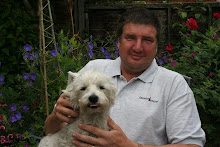We just get some lambs from him which have fallen a bit behind and not 'finished' as quickly as his best lambs. It is up to us to lavish what attention we can on them to catch them up or let them make the weight (or not) at a slower pace as suits us. If he chooses a Beltex ram (this year he borrowed him from a friend) then that's what we get. I had never heard of Beltex, so was reduced to googling the breed on the internet where, of course, there is more information than you can shake a stick at.
Interestingly the best website we came across was one covering a Connemara market close to us,
http://www.maamcrossmart.com/historysheepbeltex.htm
If I can shamelessly plagiarize for a few minutes, I now know that.....
" Beltex sheep were first introduced to Ireland from Belgium in the 1980 s. They originated from hybrid sheep bred in Belgium. The breed's main characteristics are double-muscled hindquarters, coupled with fine bones, which ensures maximum killing-out percentage of the finished lamb.Beltex is primarily a terminal sire to cross with Irish sheep and half-bred continental sheep. Beltex-sired lambs are born with ease and are thrifty.Conformation is the breed's main main attribute in producing prime lamb.Finished lambs yield a high killing-out percentage and a carcase with well-fleshed legs, good eye muscle and a long loin. The finished lamb is sought after for its superior conformation both in the home and export market.Breeders have found that quality prime lambs can be produced economically at 18 to 26 kg carcase weight, killing out at 60 per cent. Crossed with smaller ewes they are also suitable for the lightweight export market".
I have to say that 'double muscling' is not anything I really wanted to get involved in. I find the cattle which feature this trait, like Belgian Blues, slightly obscene. They have the extra block of muscle on their rump and down each hind leg like some pumped up, steroid-loaded weight lifter. They fall into that category of things which are bred TOO MUCH by mankind, along with most double and treble flowered plants and too-inbred show-dogs like those funny looking slouched-at-the-back German Shepherd dogs and, ultimately, GM food plants. I am much more comfortable with simpler flowers and traditional breeds and varieties of animals. This might be a half-baked situation which needs some thinking through
Anyway, I am pleased that our lambs are only 'sired by' a Beltex, not pure bred Beltex. They have picked up some of the meat-producing genes but do not show the 'pedigree' double muscling.
Our job, as last year, is to teach them to love us and persuade them to put on lots of weight eating our grass and a feed mix known as 'Fast Lamb Crunch'. So far the 'love us' thing is not going spectacularly well. Last year's lambs came to us straight off their Mums, and their Mums had been fed every day with 'Ewe and Lamb Nuts' which meant that they were used to racing towards Kenny expecting a feed when their Mums heard the rattle of the bucket. We just took over the process and quickly had them feeding out of our hands and hand-held buckets. Once you have done that you can confidently lead them out for a graze of the un-fenced lawn, for example, knowing that when you have done you can lead them back to their field by rattling the bucket.
[Ducklings get a first bath today]
These lambs have been separated from their Mums for three weeks now and seem to have forgotten about buckets and racing to the nearest human. If I go into the field they eye me suspiciously. They wait till I have put down the bucket and retreated and then, at some quiet point between then and my next visit they sneak over to the bucket and eat the meal.
Even that is new - they did not even eat it for the first few days. They would move off if I approached always keeping 50 yards or so between us. That, at least, is getting better. They are getting used to me and let me get to within 10 yards. I am moving the bucket a bit closer each day, hoping that soon I will be able to bring it to the gate and call them over. I am also amazed by how quiet they are. Last year's lambs seemed to be always baa-ing, greeting us as we came home, asking for food, shouting to each other. You never hear these guys! Maybe as they get more used to us and start to enjoy and want the feed, they will start talking to us. Funny little things, sheep.....
Here was a curious thing. I noticed that a couple of the large white caterpillars feeding on some nasturtiums in the yard appeared to have climbed up onto the leaves of a young Kniphofia (red hot poker) and stopped by a pale yellow 'egg mass' each. The masses were attached to the leaves by a web of silken threads and the caterpillars looked for all the world like they were standing guard. They never moved and were not eating, but looked intact and 'healthy'. I photo'd them and posted the picture on the Kent Wildlife Trust pages of Facebook asking what this was all about.
It turns out that they are not healthy or standing guard. Insect expert Jill Ireland tells me that these are "cabbage white butterfly caterpillars which have been parasitized. The larvae of the parasite have crawled out from the host and pupated themselves after eating the living insides of the caterpillar". The caterpillar is just a drying husk. The culprit is a solitary wasp called a 'braconid' known to his friends as "Apanteles glomeratus". This is a wildlife garden, so we are actually delighted that this gruesome event has been played out here - we have an ever more complex food web building up. We find it fascinating.







1 comment:
I do love your blog, Mr Care.
Post a Comment